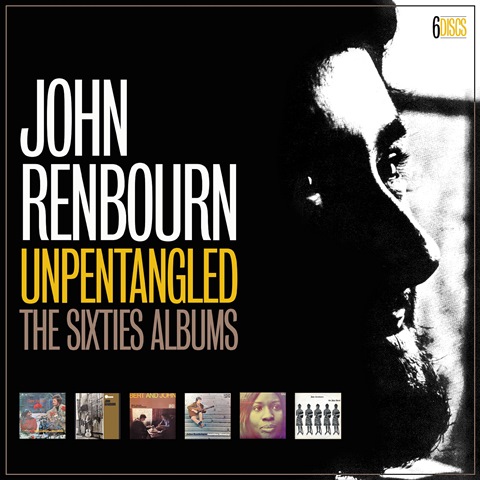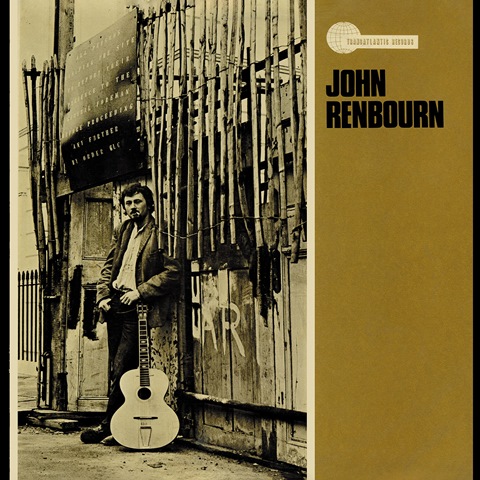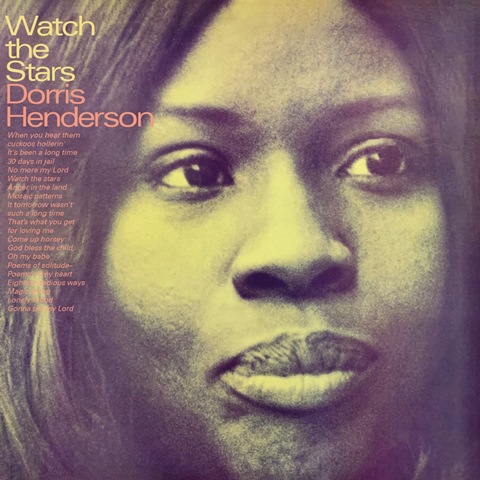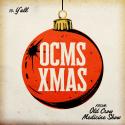Although British folk-jazz stylists Pentangle played their first official concert in May 1967, their name is borrowed for the title of Unpentangled, a box set of their guitarist John Renbourn’s work on album which kicks off two years earlier. It’s not the disconnect it might seem from the billing as the set includes his 1966 collaborative album Bert and John, made with Pentangle's other guitarist Bert Jansch. The band’s singer Jacqui McShee is heard on Renbourn’s Another Monday album, issued later that year. Their bassist Danny Thompson appears on early 1967’s Watch the Stars, which Dorris Henderson made with Renbourn.
In tracking back, Unpentangled makes it clear that Pentangle coalesced rather than formed. After listening, what’s also apparent is how tangled a trail Renbourn, who died in 2015, charted before his absorption into Pentangle.
 The six albums collected in this clamshell box set are Dorris Henderson & John Renbourn’s There You Go! (issued in February 1966), John Renbourn (March 1966), Bert Jansch & John Renbourn’s Bert And John (September 1966), Another Monday (November 1966), Dorris Henderson’s Watch The Stars (February 1967) and Sir John Alot Of Merrie Nglandes Musyk Thyng & Ye Grene Knyghte (June 1968), released after Pentangle had formed. Excepting Another Monday, each includes bonus tracks: either alternate versions unissued at the time or non-album single sides.
The six albums collected in this clamshell box set are Dorris Henderson & John Renbourn’s There You Go! (issued in February 1966), John Renbourn (March 1966), Bert Jansch & John Renbourn’s Bert And John (September 1966), Another Monday (November 1966), Dorris Henderson’s Watch The Stars (February 1967) and Sir John Alot Of Merrie Nglandes Musyk Thyng & Ye Grene Knyghte (June 1968), released after Pentangle had formed. Excepting Another Monday, each includes bonus tracks: either alternate versions unissued at the time or non-album single sides.
As the artist credits confirm, not all were solo sets. One was not even conceived as an album. There You Go! found Renbourn accompanying the transplanted American singer Dorris Henderson; John Renbourn collected studio demos recorded during late 1965 without their release in mind, and Bert And John was a collaboration between to two titular players. The fourth album here, Another Monday, was Renbourn’s first as-such solo outing. While this suggests Renbourn was happy as an accompanist and maybe fine with not taking a front-line credit, it’s also a valuable reminder that bigger pictures can lie beneath the surface.
There You Go!, the earliest album, is a product of its time – Renbourn said it was an accurate record of his and Henderson’s club act of the period. Traditional folk material like “Sally Free and Easy” is heard alongside blues and an uncomfortable, presumably audience-satisfying, version of “Mr Tambourine Man”. Renbourn’s dextrous guitar shows he took stylistic shifts in his stride. As a time-capsule artefact, There You Go! fascinates but at this remove Henderson’s theatricality and tendency to oversing dominates, making for an album which hasn’t worn well.
 Although solo and taped before There You Go!, John Renbourn is another snapshot of what was played live and again demonstrates versatility. A track not originally issued on the album is a version of Jackson C Frank’s “Blues Run the Game”, proof of an acute awareness of what was going on in the clubs.
Although solo and taped before There You Go!, John Renbourn is another snapshot of what was played live and again demonstrates versatility. A track not originally issued on the album is a version of Jackson C Frank’s “Blues Run the Game”, proof of an acute awareness of what was going on in the clubs.
Bert and John similarly evinces a hop-scotch outlook as it roams even more widely than the preceding albums: Charles Mingus’ “Goodbye Pork Pie Hat” is tackled. While rootsy, all three albums are square pegs which don’t fit the folk hole.
By the time of Bert and John, it was obvious Renbourn didn't subscribe to a traditionalist stance and wasn’t confined by genre boundaries. The assured Another Monday rams this home with its mix of a version of “I Know You Rider”, blues associated with Blind Boy Fuller, a spiritual and by bringing McShee on board. The oboe and guitar duet “One For William” is extraordinary.
 Just before Pentangle came together Renbourn reunited with Henderson for the predictably eclectic Watch The Stars, the better of the two albums the duo made. Buyers though would be forgiven for not immediately realising it was made by a partnership as he wasn't credited on the front cover. The wonderful “Mosaic Patterns” was co-written by Henderson with Anne Briggs, and a version of Briggs’ “The Time has Come” is also heard. Dylan and Gordon Lightfoot songs are also covered. A remarkable non-album single version of Love’s “Message to Pretty” is appended to the tracklisting. As Henderson – whose singing is generally more reined-in – was writing and Renbourn was contributing arrangements, the album posits the what-if of what a follow-up album by the duo without outside material may have sounded like.
Just before Pentangle came together Renbourn reunited with Henderson for the predictably eclectic Watch The Stars, the better of the two albums the duo made. Buyers though would be forgiven for not immediately realising it was made by a partnership as he wasn't credited on the front cover. The wonderful “Mosaic Patterns” was co-written by Henderson with Anne Briggs, and a version of Briggs’ “The Time has Come” is also heard. Dylan and Gordon Lightfoot songs are also covered. A remarkable non-album single version of Love’s “Message to Pretty” is appended to the tracklisting. As Henderson – whose singing is generally more reined-in – was writing and Renbourn was contributing arrangements, the album posits the what-if of what a follow-up album by the duo without outside material may have sounded like.
The question was unanswered as Pentangle soon became Renbourn’s focus. Sir John Alot Of Merrie Nglandes Musyk Thyng & Ye Grene Knyghte was issued between their first two albums and raises other questions. Did Renbourn think the band had legs? Was he hedging his bets? Notwithstanding these imponderables, the album is encapsulated by what he said on his website: it’s “in the half-and- half department. Side A comprised mainly of jazzy/bluesy material...and Side B was more renaissancy/medievally sounding with folk tunes arranged somewhat in that vein…they were ideas had been on the go for quite a while. Before my involvement in folk and blues in fact.”
Bringing these albums together for the first time foregrounds Renbourn’s magpie-mindedness. Furthermore, by not pushing himself up-front during the pre-Pentangle period he was not as immediately identifiable his contemporaries Davey Graham and Bert Jansch. This is not to say that he was of lesser stature, but instead that that a little digging was needed to find the goods. Handily, the diligent Unpentangled reduces the effort of that digging to zero.
- Next week: Massive and important box set dedicated to American cult figure Peter Laughner
- Read more reissue reviews on theartsdesk
- Kieron Tyler’s website















Add comment